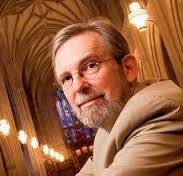It is the conclusion of Richard Hays that we “must learn to read Israel’s Scriptures not only through the filtering lens of modern critical methods, but also through the eyes of John and other authors of the canonical Gospels” (p. 93). Thus “the hermeneutical key to this intertextual dialectic is the practice of figural reading: the discernment of unexpected patterns of correspondence between earlier and later events or persons within a continuous temporal stream.” Such a reading is only possible, retrospectively, and one might add, such a reading is only possible if one is a Christian and accepts that the Christ event is a game changer in how one ought to read the text. Here Hays distinguishes between the blunder of seeing the Law and the Prophets as deliberately predicting Jesus as opposed to the correct insight which see the OT as foreshadowing or prefiguring Jesus and the Christ event.
On p. 95, Hays draws an analogy between the 4 Gospel writers and four distinctive voices singing not in unison, but in polyphony, an analogy I myself stressed as a good metaphor for all the NT voices in the canon in my The Indelible Image.
On pp. 105-09 Hays states 10 principles of interpretation as guides for reading the Gospels: 1) a Gospel shaped hermeneutic necessarily entails reading backwards, a reading which is necessarily figural in character noting analogies and patterns between events and persons etc. God has scripted the whole Biblical drama such that it has multiple senses (i.e. sensus plenior). 2) More specifically the OT is to be interpreted in light of the cross and resurrection, those events are revelatory and call for a different and deeper reading of the OT in a Christological manner. 3) the diverse imaginative uses of the OT by the Gospel writers calls us to a conversion of the imagination. We must embrace a complex poetic sensibility and bid farewell to plodding literalism and rationalism. Story, metaphor, allusion, echo, reversal, irony are the things we must become more aware of. 4) for the Gospel writers the OT told the true story of the world, from creation through the fall to the acts of redemption including the calling of a people called Israel. One must pay attention to the larger narrative arc of Scripture and not see it mainly as a compilation of rules, oracles, and proof texts. 5) the Evangelists see the story of Jesus and his followers as the continuation of the OT story about Israel which means it does not repudiate nor ignore Israel’s God or Israel’s story or Israel’s Scripture contra Marcion, various Gnostics, and other anti-Semites. 6) The Gospel writers approach the OT as a unified whole, but each in their own way give attention to varying texts and witnesses. 7) The NT writers use primarily the LXX as their OT Scripture, and perhaps we should consider following their lead, following Augustine rather than Jerome. 8) the use of the OT by the Gospel writers is metaleptic, which is to say it alludes to the larger context of various texts it cites, and a fuller understanding of the meaning the Gospel writer is conveying comes from attention to the OT context. 9. All four of the Evangelists, in various ways portray Jesus as the embodiment of the God of Israel (but I would add– but not without remainder, as there is still Yahweh/the Father to be distinguished from Jesus). Jesus’ identity is mysteriously fused with the identity of God. We should stop using terms like high and low Christology, since Jesus both divine and human is part of all the Gospel accounts. 10. Finally, the God portrayed in the Gospels is viewed as both still living and active, which is why the Gospel writer’s hermeneutic can be seen as truthful. These ten points only make sense, if that is true and if what the Gospels say about Jesus is true. The God of Abraham, Isaac and Jacob is the God who is active in Jesus and the Holy Spirit, and therefore all these points above do not amount to a twisting of the OT text, or a stealing of Moses’ thunder.













